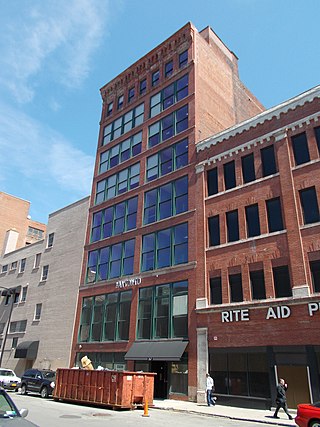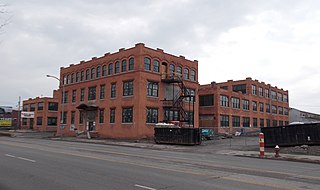
The Darwin D. Martin House Complex is a historic house museum in Buffalo, New York. The property's buildings were designed by renowned architect Frank Lloyd Wright and built between 1903 and 1905. The house is considered to be one of the most important projects from Wright's Prairie School era.

The George F. Barton House was designed by Frank Lloyd Wright, built 1903–1904, and is located at 118 Summit Avenue in Buffalo, New York. The Barton House is part of the larger Darwin D. Martin House Complex, considered to be one of the most important projects from Wright's Prairie School era.

10 Lafayette Square, also known as the Tishman Building, is a high-rise office tower located in Lafayette Square in Buffalo, New York. Completed in 1959, it is the thirteenth-tallest building in Buffalo, standing at 263 feet and 20 stories tall. The building is located adjacent to the Rand Building and built in the International Style. The structural frames for the building are not steel, but concrete beams and columns. The building architects were Emery Roth & Sons of New York City.

Villa Maria Motherhouse Complex, or Felician Sisters Immaculate Heart of Mary Convent Chapel and Convent, is a historic Roman Catholic convent located at Cheektowaga in Erie County, New York. It is included in the Roman Catholic Diocese of Buffalo. It was constructed in 1927, and is a three-part Gothic Revival building that was built for the Felician Sisters of St. Francis to house a boarding and day high school, public and private chapels and the Motherhouse/Novitiate. The school, known as Villa Maria Academy, closed in 2006. The school property was repurposed as affordable housing for seniors.

There are 75 properties listed on the National Register of Historic Places in Albany, New York, United States. Six are additionally designated as National Historic Landmarks (NHLs), the most of any city in the state after New York City. Another 14 are historic districts, for which 20 of the listings are also contributing properties. Two properties, both buildings, that had been listed in the past but have since been demolished have been delisted; one building that is also no longer extant remains listed.

The Architecture of Buffalo, New York, particularly the buildings constructed between the American Civil War and the Great Depression, is said to have created a new, distinctly American form of architecture and to have influenced design throughout the world.

Lafayette Avenue Presbyterian Church is a historic Presbyterian church complex located at 875 Elmwood Ave, Buffalo in Erie County, New York. The complex consists of the large cruciform-plan church building that was built in 1894 with an attached rear chapel. Adjoining them is the Community House that constructed of brick in the Tudor Revival style, that was built in 1921. The main church building is constructed of Medina sandstone with a terra cotta tile roof in the Romanesque Revival style. It features a 120-foot-tall (37 m), square bell tower with a pyramidal roof. The church cost $150,000 to build and has a capacity of 1,000 people

Alling & Cory Buffalo Warehouse is a historic warehouse building located at Buffalo in Erie County, New York. It consists of a six-story, "L" shaped, 120,000-square-foot (11,000 m2) former paper warehouse building built in 1910-1911 for the Alling & Cory company of Rochester, with a one-story, brick loading dock addition built in 1926. It is built of reinforced concrete with classical detailing and considered to be of the "Daylight Factory" design. The building has been rehabilitated into an apartment complex.

Kensington Gardens Apartment Complex is a historic apartment complex located at Buffalo in Erie County, New York. It was built in 1941–1942 and is a multi-unit apartment complex containing a total of 280, one-, two- and three-bedroom apartments in a variety of detached and semi-attached buildings in the Colonial Revival style. The 59 contributing buildings are grouped around grassed courts. There are 10 court areas created on the site and three building types within courts. It is an example of a World War II-era worker housing community built with financing by the Federal Housing Administration (FHA).

The Industrial Complex at 221 McKibbin Street is an American historic industrial complex, located in the East Williamsburg neighborhood of the Brooklyn borough of New York City, New York.

Midwest Steel & Iron Works was a metal fabrication company based in Denver, Colorado. Founded in 1893, the company was known for a time as the Jackson-Richter Iron Works. The company was one of the "oldest and largest metal fabricators" in Denver. The company built both structural and ornamental components for structures throughout Colorado, Wyoming, and New Mexico. The company's headquarters on Larimer Street in Denver includes an Art Deco office building and consists of a four-building complex that is itself considered a historic industrial site. The complex served as the company's headquarters from 1923 to 1983.
Esenwein & Johnnson was an architectural firm of Buffalo, New York.

Buffalo Meter Company Building is a historic daylight factory building located in Buffalo, Erie County, New York. It was designed and built by the Lockwood, Green & Co. engineering firm in 1915-1917 and is a four-story, reinforced concrete building faced in red brick. It has a fifth floor penthouse, raised basement, a large three story addition built in 1945, and two story office addition built in 1949. The building measures 284 feet by 82 feet.

Turner Brothers' Building–American Household Storage Company is a historic manufacturing and warehouse building located at Buffalo in Erie County, New York. The original section was built about 1848, and it is a four-story, wood frame, brick faced building in the Gothic Revival style. A six-story, two bay reinforced concrete addition was built in 1910. The building has three-story rear additions built in 1889 and 1940.

Houk Manufacturing Company, also known as Houk Wire Wheel Corporation, is a historic factory complex located at Buffalo in Erie County, New York. It consists of one- and two-story, brick factory buildings in a complex built in stages between 1910 and 1930. The original "L"-shaped complex built in 1910 consists of the two-story office building with an Ionic order portico, one-story machine shop, one-story warehouse, and one-story forge shop. It was listed on the National Register of Historic Places in 2014.

H. A. Meldrum Company Building is a historic department store building located at Buffalo in Erie County, New York. It was built about 1909 and is an eight-story, reinforced concrete commercial building with brick veneer walls. It was built as an addition to the Meldrum department store located at 460-470 Main Street. The H. A. Meldrum Company operated from 1897 to 1922. Its founder, Herbert Alexander Meldrum (1870-1960), was the son of Alexander Meldrum one of the founders of AM&A's.

Taylor Signal Company-General Railway Signal Company is a historic industrial complex located in Buffalo, Erie County, New York. It was designed by the architectural firm of Esenwein & Johnson and built between 1902 and 1906. The daylight factory complex consists of a rectangular two and three-story brick factory building with a central light court and wings. It has a three-story brick office building fronting on Elmwood Avenue and connected to the factory by a hyphen. The office building features Gothic Revival style design elements. The complex housed the Taylor Signal Company/General Railway Signal Company until 1907, when operations were moved to Rochester, New York. Afterwards, it housed a number of manufacturing companies including the Century Telephone Construction Company, General Drop Forge Company, Curtiss Aeroplane and Motor Company, and Lippard-Stewart Motor Car Company. The complex has been renovated to house a hotel, banquet facility, and loft apartments.

Herschell–Spillman Motor Company Complex, also known as the Remington Rand, Inc. Complex, is a historic daylight factory complex located at North Tonawanda, Niagara County, New York. The original section was built about 1895 as the powerhouse for the Buffalo and Niagara Falls Electric Railway. Later reinforced concrete and brick factory additions were made for the Herschell Spillman Company in about 1913, 1917, 1920, and 1920–1921. These include a four-story, section and additions made to earlier buildings to raise them to four stories and form an "L"-shaped complex. Also on the property is a five-story water tower. Herschell Spillman occupied the plant until it was sold to Remington Rand in 1925. Remington Rand continued operations at the factory until about 1965. The buildings have been renovated into loft apartments.

American Radiator Company Factory Complex, also known as the Pierce Plant, American Radiator & Standard Sanitary Stamping Plant, Institute of Thermal Research, Equipment Plant, and Malleable Foundry, is a historic factory complex located in Buffalo, Erie County, New York. The complex was built between 1891 and 1959, originally by Pierce Steam Heating Company and expanded by its successor the American Radiator Company. It consists of three distinct sections: 1.) the Institute of Thermal Research, 2.) the Equipment Plant, and 3.) the Malleable Foundry. American Radiator amalgamated with Standard Sanitary Manufacturing Company in 1929 to form the American Radiator and Standard Sanitary Corporation, later becoming American Standard in 1967. The Institute of Thermal Research section is an administrative / laboratory building that is a two-story brick building with a stone foundation and an "E"-shaped plan. The original section includes Prairie School design elements. Additions to the factory buildings were made in 1906 and 1910 by prominent Buffalo architect Edward Brodhead Green.






















